
Knee & Leg
Treatment at Platinum Physiotherapy will help resolve your knee and leg problems and facilitate your recovery.
The leg is prone to a variety of injuries due to repetitive forces involved in weight bearing movements such as running, jumping and twisting.
Our physiotherapists are experienced at treating conditions affecting the leg and provide high quality treatment tailored to you. We provide assessment and treatment for common knee and leg injuries including:
- Hamstring pain
- Quad pain
- Iliotibial band syndrome
- ACL injury
- Anterior Knee Pain
- Bakers Cyst
- Knee Trauma Operation
- LCL injury
- MCL injury
- PCL injury
- Calf Pain
- Calf Strain
- Compartment Syndrome
- Sciatica
- Shin Pain
- Shin Splints
Physiotherapy will relieve pain and swelling and restore range of movement, strength, balance and stability, to enable you to reach your goals and achieve your maximum of physical functioning.
An initial assessment will determine the underlying cause of your knee and leg problem. A graduated rehabilitation program will then be developed to ensure that your return to everyday activities, sport, hobbies as soon as possible with confidence and success.
Hamstring Pain
Hamstring muscle injuries are common in sports that involve running and kicking.
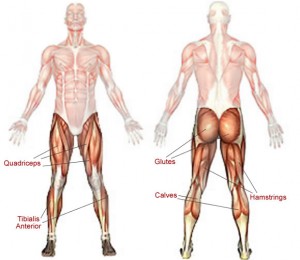 Physiotherapy for a person with a hamstring injury will focus on:
Physiotherapy for a person with a hamstring injury will focus on:
- Reducing pain and swelling
- Improving range of movement and prevent stiffness
- Improving muscle strength
- Preventing re-injury
- Promoting recovery
- Facilitating return to sporting activities as soon as possible
- An initial assessment will assess the nature of your hamstring pain and develop a progressive treatment program suited to you which may include:
- Ice to reduce swelling
- Ultrasound to promote healing
- Passive and active stretching exercises to lengthen soft tissue
- Soft tissue massage to relieve tension and pain
- Structured exercise program including an improved warm up, aerobic training and cool down to get you back to your activities gradually
- Muscle strengthening exercises of the trunk, hip and leg muscles once pain and swelling is reduced
At Platinum Physiotherapy we will also advise you on how to pace your activity so that you return to sport and everyday tasks with confidence and success. Physiotherapy will promote healing, reduce pain and improve muscle strength and flexibility and speed up your recovery.
Contact Us
Quad Pain
Quad pain is often caused by a direct blow to the muscle during sporting activities.
If the quad muscles have torn (muscle strain) the site of pain is usually well localised in the front of the thigh. Muscle strains occur in the mid belly of the muscle following an increase in running speed or extra distance kicking.
If the pain is variable and not clearly localised it may be referred pain from the hip joint, the sacroiliac joint, the lumbar spine or nerve structures.
Physiotherapy following a quad injury will be aimed at:
- Reducing pain and swelling
- Improving range of movement and preventing stiffness
- Improving muscle strength
- Preventing re-injury
- Promoting recovery
- Facilitating return to sporting activities as soon as possible
At Platinum Physiotherapy an initial assessment will identify the cause of your quad pain and an individualised treatment program will be developed which may include:
- Ice to reduce swelling
- Ultrasound to promote healing
- Passive and active stretching exercises to lengthen soft tissue
- Soft tissue massage to relieve tension and pain
- Structured exercise program including an improved warm up, aerobic training and cool down to get you back to your activities safely and effectively
- Muscle strengthening exercises for the trunk, hip and leg muscles once pain and swelling is reduced
Your physiotherapist will also advise you on how to pace your activity so that you return to sport and everyday as soon as possible and reduce the risk of re-injury.
Physiotherapy will promote healing, reduce pain and improve muscle strength and flexibility and speed up your recovery.
Contact Us
Iliotibial Band Syndrome
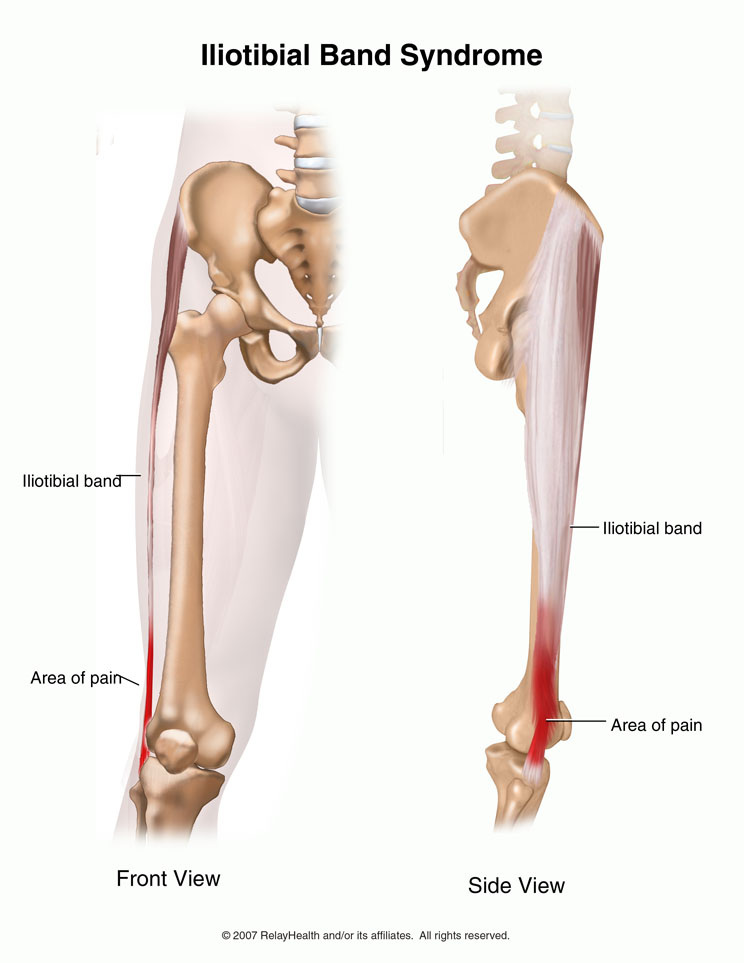 The Iliotibial (IT) band is the thick sheath of connective tissue that runs from the hip bone (femur) down the outside of the thigh and attaches to the outside of the shin bone(tibia). It acts to extend (straighten) the leg and abduct the hip (move it sideways).
The Iliotibial (IT) band is the thick sheath of connective tissue that runs from the hip bone (femur) down the outside of the thigh and attaches to the outside of the shin bone(tibia). It acts to extend (straighten) the leg and abduct the hip (move it sideways).
As this band passes over the bony part on the outside of the knee, it causes friction which leads to pain. Iliotibial band syndrome is sometimes referred to as runner’s knee or Iliotibial band friction syndrome which all mean the same thing.
Symptoms of Iliotibial band syndrome are:
- A burning sensation on the outside of the knee (most common), or along the entire sheath.
- Swelling of the knee
- Pain worsens when the foot strikes the ground
- Pain when running downhill
- Weakness in hip abduction
- Pain when the knee is extended (straightened).
- Causes of this type of injury are:
- Over-pronation (foot rolls inward and toes turn outward)
- A tight or wide IT band, bow legs
- Weak hip muscles
- Overuse
- Excessive hill running or increasing mileage too quickly
- Leg-length discrepancy
- Insufficient warm-up or cool down
A rehabilitation program and changes to your practice routine can bring about positive results. Rehabilitation will consist of manual therapy to relieve tightness in the IT band and get rid of trigger points in the gluteus (hip muscles). Strengthening of the hip abductors (muscles that move the hip outwards) are also critical to relieving this condition.
The athlete can rest and apply cold therapy to the knee to reduce pain. Minimizing downhill running or eliminating it altogether will also be helpful. Wearing an orthotic support to reduce over-pronation is often recommended.
The goals of rehabilitation of runner’s knee or Iliotibial band syndrome are to:
- Reduce initial pain and inflammation with the use of ice and ultrasound.
- Stretch the Tenser Fascia Latae muscle (a small muscle at the top of the thigh that helps to abduct the hip) and the iliotibial band to remove tightness.
- Strengthen the tendon and muscles.
- Gradual return to full fitness.
- Prevent recurrence of the injury
IT band syndrome is a condition that takes a long time to go away, months or even more than a year. Even after symptoms appear to cease, you still need to continue with prescribed exercises. It is therefore imperative that you consult a physiotherapist to help you get on the road to recovery. They will guide you in the proper way to stretch – you should not overstretch – and perform the strengthening exercises.
ACL injury
Physiotherapy for Anterior Cruciate Ligament (ACL) injury
A person with an ACL injury will benefit from physiotherapy treatment. Tears of the ACL usually occur following sporting injuries, e.g. football, basketball, netball and skiing and can have a significant impact on a persons mobility and independence with everyday activities, such as climbing the stairs.
Treatment at Platinum Physiotherapy will promote your recovery and get you back to the sports you enjoy as soon as possible with safety and confidence.
Benefits of physiotherapy following an ACL injury include:
- Reducing pain
- Reducing swelling
- Improving pain free range of movement
- Increasing muscle strength
- Improving balance and proprioception (awareness of limbs in space)
- Enhancing overall fitness
- Promoting independence with everyday activities
- Speeding up recovery and return to sport
Your physiotherapist will advise and support you on when and how to commence the right activities at the right time to improve flexibility, strength and function in a safe and effective way.
Our specialist musculoskeletal physiotherapists are experienced at treating people following an ACL injury and provide comprehensive assessment and treatment to ensure you make the best recovery. Treatment will be tailored to the activities you enjoy and may include:
- Electrotherapy and ICE to reduce swelling and relieve pain
- Gentle range of movement exercises to relieve pain, stiffness and swelling
- Isometric strengthening exercises
- Once pain free range has been achieved your strengthening exercises will be progressed through range
- Balance training
- Core stability work
- Functional activities based around everyday tasks
- Sport specific exercises
Your physiotherapist will use a variety of specialist equipment such as weights, therabands, gym balls, trampette, wobbleboard and treadmill, to help you return to your normal sporting activities as soon as possible to the best of your ability.
Contact Us
Anterior Knee Pain
What is anterior knee pain?
Anterior knee pain refers to pain over the front of the patella (kneecap) aggravated by climbing the stairs, prolonged bent-knee sitting, squatting, running and jumping activities.
What causes anterior knee pain?
There are many causes of anterior knee pain which may include:
- Strained tendons (tendinitis)
- Poor alignment of the patellofemoral joint
- Softening of the cartilage cartilage that lines the underside of the kneecap (chondromalacia patellae).
- Biomechanical disadvantages such as flat feet
- Tightness or weakness of the muscles on the front (quads)and back (hamstrings) of your thigh
- Repetitive strain
- Inflammation of the bursa inside the knee (bursitis)
What are the symptoms/effects of anterior knee pain?
People with anterior knee pain usually experience an aching pain at the front of the knee and around or under the knee cap that may increase to sharper pain with activity.
Physiotherapy for anterior knee pain
Our specialised physiotherapist at Platinum Physiotherapy will provide accurate assessment and treatment as well as a careful explanation of your condition to ensure an optimal outcome in the short and long term.
Physiotherapy treatment for anterior knee pain will vary according to the exact diagnosis and the underlying causes but may include:
- Stretching exercises for the hamstrings, quadriceps, calf muscles and iliotibial band
- Strengthening exercises for the quadriceps, hip abductor and hip external rotator muscles
- Patellar taping techniques to correct the position of the patella
- Advice about orthotics
- Patella mobilisation
- Core stability exercises
- Soft tissue massage to relieve pain and stiffness
Your rehabilitation program will be tailored to your needs and lifestyle to ensure you get the most out of your treatment.
Physiotherapy will reduce pain and stiffness, promote healing and increase muscles strength and flexibility in order to get you back to your normal activities as quickly as possible.
Contact Us
Bakers Cyst
 Bakers Knee Cyst
Bakers Knee Cyst
The cartilage and tendons in your knees rely on a lubricating fluid called synovial fluid. This fluid helps your legs swing smoothly and reduces friction between the moving parts of your knees.Synovial fluid circulates throughout your knee and passes in and out of various tissue pouches (bursae) throughout your knee. A valve-like system exists between your knee joint and the bursa on the back of your knee (popliteal bursa). This regulates the amount of synovial fluid going in and out of the bursa.But sometimes the knee produces too much synovial fluid.
Most commonly this is caused by an inflammation of the knee joint, such as occurs with various types of arthritis or a knee injury, especially a cartilage tear.When the popliteal bursa fills with fluid and expands, the result is a bulge called a Baker’s cyst. Treating the probable underlying problem usually relieves the swelling and discomfort of a Baker’s cyst.
These cysts occur most often in adults between 55 and 70 and in children between 4 and 7 years old. Up to one in five people with other knee problems may develop a Baker’s cyst.
Signs & Symptoms
In some cases, a Baker’s cyst causes no pain and goes unnoticed. The signs and symptoms you may notice can include:
- Swelling behind your knee, and sometimes in your leg or foot
- Knee pain when you fully extend your knee or when you are active
- Tightness in the back of your knee, sometimes a bulge can be felt
- Stiffness
Complications
Rarely, a Baker’s cyst bursts and synovial fluid leaks into the calf region, causing sharp pain in the knee, swelling and sometimes redness of the calf. These signs and symptoms closely resemble those of a blood clot in your leg. If you have swelling and redness of your calf, you’ll need prompt medical evaluation, because a blood clot may require urgent treatment.
Physiotherapy Treatment
If the cyst is very large and causes a lot of pain, your physiotherapist may use treatments including. Applying ice packs, a compression wrap, and crutches may help reduce pain and swelling. Gentle range of motion and strengthening exercises for the muscles around your knee may also help to reduce your symptoms and preserve knee function.
If your doctor or physiotherapist determines that a cartilage tear is causing the overproduction of synovial fluid, he or she may recommend surgery to remove or repair the torn cartilage.
In some instances, particularly if you have osteoarthritis, the cyst may not go away even after your doctor treats the underlying cause. If the cyst doesn’t get better, causes pain and interferes with your ability to bend your knee, or if — in spite of aspirations — fluid in the cyst hinders knee function, you may need to be evaluated for surgery to remove the cyst.
Knee Trauma Operation
Some people require orthopaedic surgery following a knee injury.
Physiotherapy treatment must commence from the time of injury, not surgery, as this may be months later.
Pre-operative physiotherapy
Pre-operative physiotherapy starts with acute injury management and progresses to improving strength and range of movement to allow accelerated post-operative recovery.
Pre-operative physiotherapy may include:
- Ice and heat therapy in the initial stages to reduce pain and swelling
- Advice about the modify activity
- Stretching the muscles in the leg and hips
- Strengthening exercises
- Soft tissue massage to lengthen any tight muscles around the knee and reduce pain
- Taping
- Information about your surgical procedure and what to expect afterwards
Post-operative physiotherapy
Our physiotherapists at Platinum Physiotherapy commonly treat people following knee operations such as arthroscopies, meniscectomies, ligament reconstructions and knee replacements to promote healing and enhance recovery.
Post-operative physiotherapy may include:
- Heat therapy to relax tight and painful muscles
- Ultrasound to accelerate healing
- Gait training with or without a walking aid and practising to gradually weight bear on your affected leg to encourage healing and improve independence
- Practising transfers such as getting up from sitting, getting on/off the bed, chair, commode
- Practising stairs
- Exercise program once pain has settled to improve strength and flexibility in the leg and hip muscles.
- Exercises to improve physical fitness
- Core stability exercises
- Balance training
- Advise on how to modify activity and when to progress exercises safely
Physiotherapy treatment will be individualised and tailored upon your current symptoms and level of function to improve your mobility and increase your independence with everyday activities.
At Platinum Physiotherapy, physiotherapy treatment before and after your knee operation will ensure you get back to the activities you enjoy to the best of your ability.
Contact Us
LCL injury
Physiotherapy for a Lateral Collateral Ligament (LCL) injury
LCL injuries typically occur during sporting activities when too much force is placed on the inside of the knee causing the fibres in the ligament to tear. Physiotherapy treatment will get you started on the right activities at the right time following a lateral collateral ligament (LCL) injury, to promote healing and facilitate recovery as quick as possible.
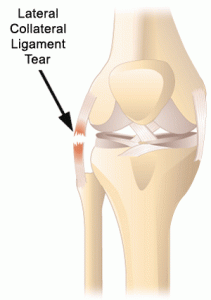 Benefits of physiotherapy treatment at Platinum Physiotherapy include:
Benefits of physiotherapy treatment at Platinum Physiotherapy include:
- Relieving pain
- Reducing swelling
- Restoring and improving range of movement and muscle strength
- Enhancing balance
- Improving coordination
- Facilitating return to sport
Your physiotherapy program will restore strength, stability and range of movement through a combination of electrotherapy, hand on techniques and exercise. An initial assessment with one of our specialised physiotherapists will look at your current level of function, in order to develop an individualised treatment program which may include:
- Electrotherapy to facilitate healing and reduce pain and swelling
- Deep tissue friction and soft tissue massage to improve circulation and enhance healing
- Progressive exercise program to stretch and strengthen the muscles surrounding the joint, improving control and stability
- Balance training to maximise function and prevent re-injury
- Activities based around everyday tasks
- Exercises tailored to your sport to facilitate recovery and improve aerobic fitness
Our specialised musculoskeletal physiotherapists will ensure you get the most out of your treatment and return to your normal sporting activities as soon as possible, by setting short and long term treatment goals tailored to you.
Contact Us
MCL injury
Physiotherapy for a Medial Collateral Ligament (MCL) injury
The medial collateral ligament (MCL) is commonly injured in sporting activities such as football, when the outside of the knee joint is struck and MCL is stretched too far, causing a tear in the ligament.
At Platinum Physiotherapy we provide specialist assessment and treatment for MCL injuries to ensure you make the best possible recovery and get back to your previous level of activity or sport as soon as possible.
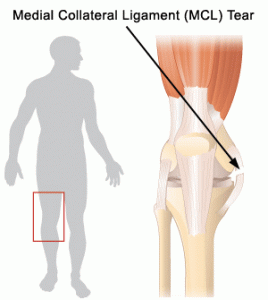 Benefits of physiotherapy include:
Benefits of physiotherapy include:
- Alleviating pain and swelling
- Relieving stiffness
- Restoring and increase range of movement
- Increasing balance and co-ordination
- Improving muscle strength
- Enhancing stability of the knee
- Preventing re-injury
- Promoting a speedy recovery
- Rehabilitation following an MCL injury is best provided by a specialist musculoskeletal physiotherapist
At Platinum Physiotherapy, we have experienced musculoskeletal physiotherapists, who use a combination of hands-on techniques, electrotherapy and exercise to promote healing and maximise physical function.
Physiotherapy treatment will depend on you individual needs and requirements but may include:
- Electrotherapy to reduce pain, swelling and facilitate healing
- Deep tissue friction and soft tissue massage to improve circulation and enhance healing
- Structured exercise program to stretch and strengthen the muscles which surround and stabilise the knee.
- Balance training
- Activities based around everyday tasks
- Sport-specific exercises
- Exercises to improve aerobic fitness
Physiotherapy treatment will ensure you make the best possible recovery following your injury and return to sport with confidence and success.
Contact Us
PCL injury
Physiotherapy for Posterior Cruciate Ligament (PCL) injury
People commonly damage their Posterior Cruciate Ligament (PCL) by a powerful force to the front of the upper shin, making it painful to walk.
A person with a PCL injury will benefit from physiotherapy. A specialised rehabilitation programme from one of our dedicated physiotherapists at Platinum Physiotherapy will improve the movement in your knee and strengthen your muscles around it, so that you can return to everyday and sporting activities safely and effectively as soon as possible.
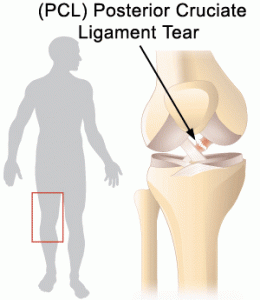 Benefits of physiotherapy for a PCL injury include:
Benefits of physiotherapy for a PCL injury include:
- Reducing pain
- Reducing swelling
- Improving joint flexibility
- Improving muscle strength
- Improving balance and coordination
- Returning you back to exercise/sport/hobbies with success
Your physiotherapist will develop a structured rehabilitation program tailored to you to gradually strengthen your knee and keep your muscles flexible.
Our musculoskeletal physiotherapists use a variety of techniques and equipment, to promote healing and aid recovery and may include:
- Electrotherapy to reduce swelling and accelerate healing
- ICE to reduce swelling and relieve pain
- Gentle range of movement exercises to relieve pain, stiffness and swelling
- Graduated exercise program including stretching and strengthening activities using therabands/weights.
- Activities to improve balance using trampettes/wobbleboards
- Core stability exercises
- Functional activities based around everyday tasks
- Sport specific exercises using treadmill, gym balls
Your treatment program will progress you through a range of activities including short and long term goals, to ensure that you return to walking, running, and training at your normal level with success.
Contact Us
Calf Pain
Calf pain is a common presenting complaint and if not managed properly it can persist for months or recur.
What causes calf pain?
Common causes of calf pain include:
- Muscle strains – calf strains are the most common cause of calf pain.
- Cramps
- Biomechanics – such as flat footedness
- Referred Pain – from the lumbar spine or knee joint
Physiotherapy for calf pain
An initial assessment with one of our specialised physiotherapists at Platinum Physiotherapy will diagnose the cause of your calf pain and develop a treatment plan suited to this.
Physiotherapy treatment will depend on your current symptoms, and the underlying cause of your calf pain but may include:
- Ice therapy to reduce swelling
- Ultrasound to promote healing
- Deep tissue massage and trigger point therapy to relieve muscle tension and stiffness
- Passive stretching
- Calf strengthening exercises once pain has settled to get you back to your sporting activities as soon as possible.
- Hands on treatment such as manipulation or mobilisation is often administered in conjunction with an exercise program to relieve pain and stiffness
- Advice about orthotics to correct your foot posture
At Platinum Physiotherapy, physiotherapy treatment will not only alleviate your calf pain but prevent future reoccurrence.
Contact Us
Calf Strain
Calf strain ranges from the tearing of a few muscles fibres to completely rupturing the muscles itself causing pain and reduced function.
What causes calf strain?
A sudden contraction of the calf muscle such accelerating from a stationary position or when lunging forwards to play a ball at squash or tennis can cause a calf strain.
A calf strain may also be caused by gradual wear and tear associated with repetitive jumping and distance running or walking.
What are the symptoms/effects of calf strain?
The main symptoms of a calf strain injury is pain which can range from a still cramping and tightness during the stretching or contraction of the muscles at the back of the lower leg, to immediate pain and even soreness when touched. In the worse cases, there can be acute stabbing pain and the person will be unable to walk meaning the muscle may have completely torn. Often bruising and swelling occurs.
Physiotherapy for a calf strain
Physiotherapy treatment is vital to hasten the healing process, ensure the best outcome as soon as possible and minimise the likelihood of re-injury.
Physiotherapy treatment at Platinum Physiotherapy will be tailored to your individual needs but may include:
- Ice and heat therapy to reduce pain and swelling
- Soft tissue massage to facilitate healing
- Ultrasound
- Joint mobilisation
- Graduated exercise program which will include leg and hip stretching and strengthening exercises and how to progress these safely and effectively
- Running program promoting a gradual return to activity
- It is important to seek physiotherapy treatment as soon as possible for the best possible results in the short and long term.
- Physiotherapy treatment will reduce pain and swelling, promote healing and improve muscle strength and flexibility in order to get you back to sport and everyday activities in good time
Compartment Syndrome
There are various compartments in the lower leg that enclose the muscles. The posterior muscle compartment is the largest compartment in the lower leg that contains the calf muscles.
What is Posterior Compartment Syndrome?
Posterior Compartment Syndrome is a painful condition occurring when the muscles, nerves and blood vessels out-grow the space within the compartment created by the enclosing sheath. This increases the pressure inside the area and consequently on everything within the compartment causing pain.
What Causes Posterior Compartment Syndrome?
Posterior Compartment Syndrome can be caused by any acceleration movement which involves powerfully pushing off with the feet, like running, kicking, jumping or over-extending the foot by going up onto your heals or onto your tip toes.
Other causes of posterior compartment syndrome resulting in bleeding or swelling in the compartment may include:
- Direct trauma or impact to the back of the lower leg
- Extreme physical activity
- A muscle tear or calf strain
What are the symptoms/effects of Posterior Compartment Syndrome?
The main symptoms of posterior compartment syndrome are pain and tightness along the inner aspect of the shin and / or back of the lower leg. These symptoms generally increase with exercise and decrease with rest and can occur in one or both legs.
People may also experience a burning sensation or numbness in the calf and pins and needles in the foot.
Diagnosis of Posterior Compartment Syndrome
A thorough examination by a physiotherapist or doctor will diagnose compartment syndrome.
Physiotherapy treatment for Posterior Compartment Syndrome
Your physiotherapist at Platinum Physiotherapy will initially assess your lower leg and then analyse your training methods, running gait and types of shoes to determine any contributory factors. A treatment plan will then be developed tailored to your current symptoms and diagnosis which may include:
- Alternating cold and heat therapy
- Soft-tissue massage of the calf muscles
- Modifying activity program while you recover
- Advice about orthotics and appropriate foot wear
- Mobilisation of the ankle joint
- Taping
- Stretching exercises
- Progressive strengthening exercises to improve balance and strength
- A gradual return to activity program
- Physiotherapy treatment will reduce pain and gradually increase muscles strength and flexibility so you can return you to the activities important to you as quickly and as safely as possible
Sciatica
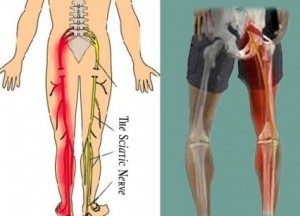 Sciatica is a specific pain that originates from the sciatic nerves which each run from one side of the pelvis through the hip and buttocks and down the leg. The Sciatic nerve forms what is effectively an electrical cable to and from the brain. Sciatica is a condition where pain, weakness or altered sensation can be experienced in the buttock, hamstring, calf or foot but stem from the spine, via the Sciatic nerve.
Sciatica is a specific pain that originates from the sciatic nerves which each run from one side of the pelvis through the hip and buttocks and down the leg. The Sciatic nerve forms what is effectively an electrical cable to and from the brain. Sciatica is a condition where pain, weakness or altered sensation can be experienced in the buttock, hamstring, calf or foot but stem from the spine, via the Sciatic nerve.
What Causes Sciatica?
Although the cause of Sciatica lies in the spine, not all sufferers will experience back pain and symptoms can be variable. The problem can manifest as back pain with leg pain, or leg pain only. The major cause of Sciatica is a disc prolapse (more commonly known as a ‘slipped disc’) at the bottom of the back. Other factors however that can cause sciatica include injury to the buttocks, prolonged external pressure on the nerve, pressure from a tight muscle or nearby structure.
Sciatic can be triggered by very small, normal movements like bending over to one side at a bad angle to pick something up, as well from suffering a trauma like falling off a ladder and landing on your back. What happens in all cases is that the sciatic nerve is compressed and consequentially causes you pain.
What are the symptoms/effects of Sciatica?
The most common symptoms of sciatica is pain which can range from mild to debilitating. Other symptoms include weakness, numbness or tingling that generally begins in the lower spine and radiates down through the hips and buttocks and down the leg.
Additional more serious symptoms may include:
- Impaired circulation.
- Numbness of muscles, or a feeling of weakness, along the nerve pathway in the leg or foot.
- Loss of bladder or bowel control.
- Difficulty in moving and controlling the leg
Physiotherapy Treatment for Sciatica
Physiotherapy treatment is very effective in the treatment of Sciatica.
Physiotherapy treatment at Platinum Physiotherapy will relieve nerve root compression and prevent further episodes of sciatic pain by teaching correct postural techniques, and exercises to correct any muscle imbalance in the spine.
Common treatments used to treat Sciatica include:
- Joint mobilisation
- Stretching
- Postural advice
- Massage therapy including trigger point techniques
- Acupuncture
- Heat therapy
- Core stability exercise
Your treatment program will be suited to your needs and lifestyle to ensure you make significant long term improvements and continue with everyday activities you enjoy will less pain and discomfort.
Contact Us
Shin Pain
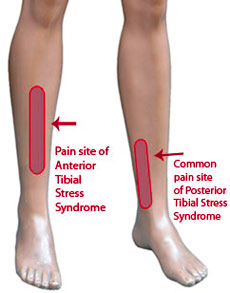 Shin pain commonly occurs following a sporting injury, particularly among runners and dancers.
Shin pain commonly occurs following a sporting injury, particularly among runners and dancers.
What causes shin pain?
Common causes of shin pain include:
- Shin splints
- Biomechanics – such as flat footedness
- Repetitive overuse
Physiotherapy for calf pain
Physiotherapy at Platinum Physiotherapy will firstly involve an assessment to diagnose the cause of your shin pain followed by a comprehensive treatment plan to enhance recovery and get you back to your sporting and everyday activities as quickly as possible.
Physiotherapy treatment will depend on the cause of your shin pain and current symptoms but may include:
- Ice therapy to reduce swelling
- Ultrasound to promote healing
- Passive stretching
- Graduated exercises program to improve muscle strength and flexibility and correct any muscle imbalances
- Advice about appropriate footwear and orthotics
- Running program
Your physiotherapist will guide you through an individualised treatment program to reduce pain, improve muscle strength and length and prevent future reoccurrence.
Contact Us
Shin Splints
What are shin splints?
The term ‘shin splints’ has been used to describe pain along the inside border of the shin commonly experienced by runners.
What causes shin splints?
Shin Splints can be caused by overusing certain muscles usually during long-distance running, especially if running on a hard surface. However, other factors are often involved such as posture and body alignment when running. Having flat feet or low arches can also be a common cause of shin splints and one factor commonly implicated in causing shin splints is over-pronation (over-flattening) of the foot.
What are the symptoms/effects of shin splints?
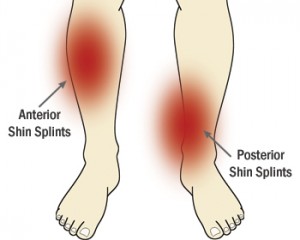 The main symptom of shin splints is pain on the inner side of the tibia during and after exercise. Sometimes there is swelling and even lumps on the bone. In some cases it is painful to bend the foot or toes downwards and the inside of the shin appears to be red.
The main symptom of shin splints is pain on the inner side of the tibia during and after exercise. Sometimes there is swelling and even lumps on the bone. In some cases it is painful to bend the foot or toes downwards and the inside of the shin appears to be red.
Physiotherapy Treatment
Physiotherapy treatment will speed up the healing process and ensure you continue to make improvements in the long term and prevent it from re-occurring.
Physiotherapy at Platinum Physiotherapy for shin splints may include:
- Alternating cold and heat therapy
- Soft tissue massage to relieve any muscle tension and break up scar tissue
- A range of exercises of strengthening and stretching exercises for the Achilles, the upper and lower calf, and the hamstrings.
- Advice about low-impact exercises such as swimming
- In the long-term you may need to change your running style in order to correct the way that the foot hits the ground, as well as making sure that good footwear is worn
- Orthotic advice to help raise fallen arches
Your physiotherapist will devise a graduated training programme to promote recovery and help you return to your usual sports activities.
Physiotherapy treatment will reduce pain and restore range of movement and strength to your muscles as soon as possible.
Contact Us




![axa_ppp_logo[1]](https://www.platinumphysio.co.uk/wp-content/uploads/axa_ppp_logo1.gif)
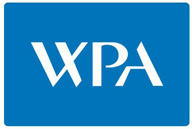
![cigna[2]](https://www.platinumphysio.co.uk/wp-content/uploads/cigna2.png)